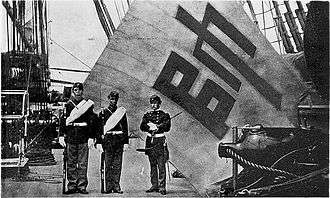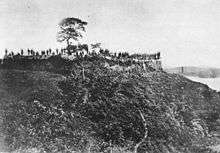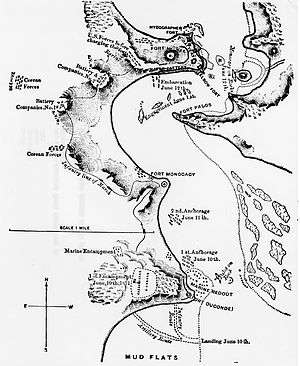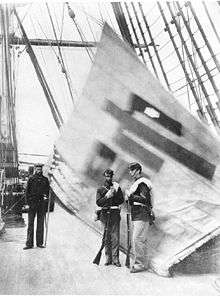United States expedition to Korea
The United States expedition to Korea, known by the Koreans as the Shinmiyangyo (신미양요: 辛未洋擾, lit. "Western Disturbance in the Shinmi (1871) Year") or simply the Korean Expedition, in 1871, was the first American military action in Korea.
| Korean Expedition | |||||||
|---|---|---|---|---|---|---|---|
 The captured Sujagi aboard USS Colorado in June 1871 | |||||||
| |||||||
| Belligerents | |||||||
|
|
| ||||||
| Commanders and leaders | |||||||
|
|
| ||||||
| Strength | |||||||
|
651 1 frigate 2 sloops-of-war 2 gunboats |
300 40 artillery pieces 6 forts 4 shore batteries | ||||||
| Casualties and losses | |||||||
|
3 killed 10 wounded 1 gunboat damaged |
243 killed 20 captured 40 artillery pieces captured 5 forts destroyed 1 fort damaged 4 shore batteries destroyed | ||||||
| United States expedition to Korea | |
| Hangul | 신미양요 |
|---|---|
| Hanja | 辛未洋擾 |
| Revised Romanization | Shinmiyangyo |
| McCune–Reischauer | Shinmiyangyo |
It took place predominantly on and around Ganghwa Island. The reason for the presence of the American land and naval force in Korea was to support an American diplomatic delegation sent to establish trade and political relations with the peninsular nation, to ascertain the fate of the merchant ship General Sherman, and to establish a treaty assuring aid for shipwrecked sailors. When Korean shore batteries attacked two American warships on June 1, a punitive expedition was launched 10 days later after the commanding American admiral failed to receive an official apology from the Koreans. The isolationist nature of the Joseon dynasty government and the assertiveness of the Americans led to a misunderstanding between the two parties that changed a diplomatic expedition into an armed conflict. On June 10, about 650 Americans landed and captured several forts, killing over 200 Korean troops with a loss of only three American soldiers dead. Korea continued to refuse to negotiate with the United States until 1882.
Initial contact
The expedition consisted of about 650 men, over 500 sailors and 100 Marines, as well as five warships:[2] Colorado, Alaska, Palos, Monocacy, and Benicia. Embarked aboard Colorado was Rear Admiral John Rodgers, and Frederick F. Low, the United States Ambassador to China.[3][4] The Korean forces, known as "Tiger Hunters", were led by General Eo Jae-yeon (Hangul; 어재연 Hanja; 魚在淵).
The Americans safely made contact with the Korean inhabitants, described as "people wearing white clothes". When they inquired about the General Sherman incident, the Koreans were initially reluctant to discuss the topic, ostensibly to avoid having to pay any recompense. The Americans consequently let the Koreans know that their fleet would be exploring the area, and that they meant no harm. This gesture was misinterpreted; Korean policy at the time prohibited foreign ships from sailing on the Han River, as it led directly to the capital city of Hanyang, modern-day Seoul. On June 1, the Korean fortress fired at the U.S. fleet as they sailed up the Ganghwa Straits, which leads to the river. The U.S. forces were not badly damaged due to "the bad gunnery of the [K]oreans, whose fire, although very hot for the fifteen minutes in which they maintained it, was ill-directed, and consequently without effect."[5] The U.S. demanded an apology within 10 days; there was no response so Rodgers decided on a punitive assault on the forts.[4]
Battle of Ganghwa

On June 10, the Americans attacked the lightly defended Choji Garrison on Ganghwa, along the Salee River. The Koreans were armed with severely outdated weapons, such as matchlock muskets but with cannons. After they were quickly overrun, the Americans moved onto their next objective, the Deokjin Garrison. The poorly armed Korean forces were kept from effective range by American 12-pound howitzers. The American troops continued on towards the next objective, Deokjin Fort, which they found abandoned. The sailors and Marines quickly dismantled this fortress and continued to Gwangseong Garrison, a citadel. By this time, Korean forces had regrouped there. Along the way, some Korean units tried to flank the U.S. forces, but were beaten off again due to the strategic placement of artillery on two hills.
Artillery fire from ground forces and Monocacy offshore pounded the citadel in preparation for an assault by U.S. forces. A force of 546 sailors and 105 Marines grouped on the hills west of the fortress (infantry troops were on the hill directly west of the fortress, while artillery troops on another hill both shelled the fortress and also covered the Americans' flanks and rear) keeping cover and returning fire. Once the bombardment stopped, the Americans charged the citadel, led by Lieutenant Hugh McKee. The slow reload time of the Korean matchlocks aided the Americans, who were armed with superior Remington rolling block carbines, in making it over the walls; the Koreans even ended up throwing rocks at the attackers.
McKee was the first to make it into the citadel, and was fatally wounded by a shot to the groin. After him came Commander Winfield Scott Schley, who shot the Korean soldier who had killed McKee.[6] The flag of the Korean commander, General Eo Jae-yŏn, called the "Sujagi" by Koreans, was captured by Corporal Charles Brown of Colorado's guard and Private Hugh Purvis of Alaska's guard.[7] General Eo was killed by Private James Dougherty.[8] While serving as the color bearer for Colorado's crew and Marines, Colorado Carpenter Cyrus Hayden planted the U.S. flag on the ramparts under heavy enemy fire. Corporal Brown, Privates Dougherty and Purvis, and Carpenter Hayden received the Medal of Honor.
The fighting lasted fifteen minutes. The total number of killed were 243 Koreans and three Americans; McKee, Seaman Seth Allen, and U.S. Marine Corps Private Denis Hanrahan.[9] 10 Americans were wounded and 20 Koreans were captured, several of whom were wounded. Five Korean forts were taken in total, with dozens of various small cannons.[10][11] The Korean deputy commander was among the wounded who were captured.[12] The U.S. hoped to use the captives as a bargaining chip to meet with local officials, but the Koreans refused, calling the captives cowards and "Low was told that he was welcome to keep the wounded prisoners".[13]
Following the military operations of June 10–12, the United States Asiatic Squadron stayed at anchorage off Jakyak Island until July 3, when they left for China.[14][15]
Aftermath
The United States was not able to achieve its objectives diplomatically, as the Koreans refused to negotiate. In fact, these events led the regent Daewon-gun to strengthen his policy of isolation and issue a national proclamation against appeasing foreigners.[16] However, there were no further attacks on foreign ships. In 1876, Korea established a trade treaty with Japan after Japanese ships approached Ganghwa Island and threatened to fire on Seoul. Treaties with European countries and the U.S. soon followed.
Nine sailors (Chief Quartermaster Grace, Quartermasters Troy, Franklin and Rogers, Boatswain's Mate McKenzie, Ordinary Seaman Andrews, Carpenter Hayden, and Landsmen Lukes and Merton) and six Marines (Corporal Brown and Privates Coleman, Dougherty, McNamara, Owens, and Purvis) were awarded the Medal of Honor, the first for actions in a foreign conflict.
Treaty of Amity and Commerce
From April–May 1882, the United States, represented by Commodore Robert W. Shufeldt of the United States Navy, and Korea negotiated and approved a 14-article treaty.[17] The treaty established mutual friendship and mutual assistance in case of attack;[18] and also addressed such specific matters as extraterritorial rights for American citizens in Korea[19] and most favored nation trade status.[20]
The treaty remained in effect until the annexation of Korea in 1910.
Gallery
 Map of the Ganghwa forts
Map of the Ganghwa forts- Korean casualties, after the attack on Fort Sondolmok (Fort McKee) by Felice Beato[21]
 Korean ship in 1871, taken by the Americans during the expedition
Korean ship in 1871, taken by the Americans during the expedition U.S. Navy officers holding a council of war aboard the Asiatic Squadron flagship, the steam frigate Colorado, off Korea in June 1871. The squadron's commander, Rear Admiral John Rodgers, leans over the table on the right.
U.S. Navy officers holding a council of war aboard the Asiatic Squadron flagship, the steam frigate Colorado, off Korea in June 1871. The squadron's commander, Rear Admiral John Rodgers, leans over the table on the right. Korean official bearing the first dispatches on board the Colorado, June 1871
Korean official bearing the first dispatches on board the Colorado, June 1871 Captured Sujagi aboard USS Colorado. From right to left: U.S. Marine Corporal Charles Brown, U.S. Marine Private Hugh Purvis, and the sailor on the left is believed to be Cyrus Hayden (U.S. Navy). All three were awarded the Medal of Honor.
Captured Sujagi aboard USS Colorado. From right to left: U.S. Marine Corporal Charles Brown, U.S. Marine Private Hugh Purvis, and the sailor on the left is believed to be Cyrus Hayden (U.S. Navy). All three were awarded the Medal of Honor.
See also
Notes
- Chay, Jongsuk (2002). Unequal Partners in Peace and War: The Republic of Korea and the United States, 1948–1953. Praeger Publishers. p. 10. ISBN 0-275-97125-2.
- The number of ships is confirmed by Lee (1984), p. 264.
- Lee (1984), loc. cit.
- Colorado Archived copy at the Library of Congress Web Archives (archived 4 October 2012). Dictionary of American Naval Fighting Ships
- "Report of Rear Admiral John Rodgers". In Reports of the Secretary of the Navy and of the Postmaster General. Washington: Government Printing Office. 1871. p. 277.
- Lexington Morning Herald November 28, 1897
- Report of Captain McLane Tilton to the Secretary of the Navy, Korea, June 16, 1871
- Report of Commander L.A. Kimberly (USN) to the Secretary of the Navy, Korea, July 5, 1871
- Dispatch from Commodore John Rodgers to the Secretary of the Navy, Corea, June 23, 1871
- Nahm (1996), p. 149.
- Rear-Admiral John Rodgers, General Order No. 32, June 12, 1871
- "The Korean War", New York Times, Vol. 20, No. 6215, August 22, 1871
- Kim Young-Sik, Ph.D. "Association for Asia Research- The early US-Korea relations". Asianresearch.org. Retrieved 18 July 2014.
- Report of Rear-Admiral John Rodgers to the Secretary of the Navy, July 5, 1871
- Deck logs for the USS Colorado, USS Alaska, USS Benecia, USS Monocacy, and USS Palos from June 10, 1871 to July 3, 1871
- Nahm (1986), p. 149-150; Lee (1984), p. 266.
- Yŏng-ho Ch'oe et al. (2000). Sources of Korean Tradition, p. 235, p. 235, at Google Books; excerpt, "Korea signed a similar accord with the United States (the Treaty of Chelump'o, 1882) that was followed by similar agreements with other Western nations;" Korean Mission to the Conference on the Limitation of Armament, Washington, D.C., 1921-1922. (1922). Korea's Appeal to the Conference on Limitation of Armament, p. 29., p. 29, at Google Books; excerpt, "Treaty and Diplomatic Relations Between the United States and Korea. Treaty of Friendship, Commerce, and Navigation dated May 22, 1882."
- Korean Mission Korea's Appeal to the Conference on Limitation of Armament, p. 29., p. 29, at Google Books; excerpt, "... Article 1."
- Korean Mission p. 29., p. 29, at Google Books; excerpt, "... Article 4."
- Korean Mission p. 29., p. 29, at Google Books; excerpt, ""... Article 14."
- [A similar version of the same scene is at .]
References
- Lee, Ki-baek, tr. by E.W. Wagner & E.J. Shultz (1984). A new history of Korea (rev. ed.). Seoul: Ilchogak. ISBN 89-337-0204-0.CS1 maint: multiple names: authors list (link)
- Nahm, Andrew C. (1996). Korea: A history of the Korean people (2nd ed.). Seoul: Hollym. ISBN 1-56591-070-2.
- Duvernay, Thomas A. (2020). Sinmiyangyo: The 1871 Conflict Between the United States and Korea. Seoul: Seoul Selection. ASIN B08BF9J9HB.
- Gordon H. Chang, "Whose "Barbarism"? Whose "Treachery"? Race and Civilization in the Unknown United States-Korea War of 1871," Journal of American History, Vol. 89, No. 4 (Mar., 2003), pp. 1331–1365 in JSTOR
- Yŏng-ho Ch'oe; William Theodore De Bary; Martina Deuchler and Peter Hacksoo Lee. (2000). Sources of Korean Tradition: From the Sixteenth to the Twentieth Centuries. New York: Columbia University Press. ISBN 978-0-231-12030-2; ISBN 978-0-231-12031-9; OCLC 248562016
External links
| Wikimedia Commons has media related to United States expedition to Korea in 1871. |
- US Naval Historical Center on 1871 US Korean campaign at the Library of Congress Web Archives (archived 2010-04-07)
- medal of Honor Link {1871} reference only
- 1871 US Korea Campaign
- The early US-Korea relations - Excerpt from "A Brief History of the US-Korea Relations Prior to 1945"
- Gateway to Shimiyangyo at the Wayback Machine (archived 2004-10-11)
- My Ganghwa dot com, a Korean site dedicated to the Ganghwa Isle at the Wayback Machine (archived 2006-09-29)
- Marine Amphibious Landing in Korea, 1871